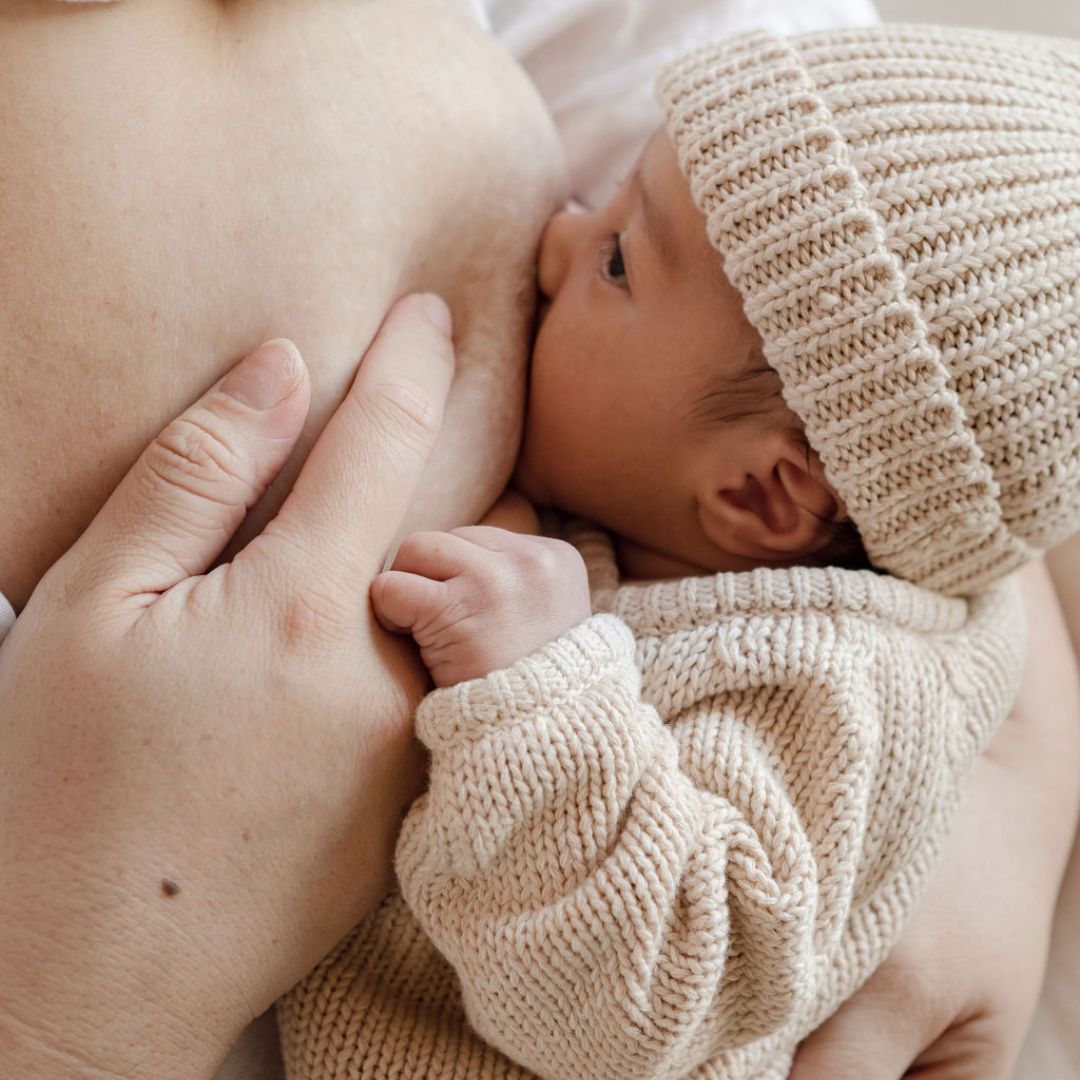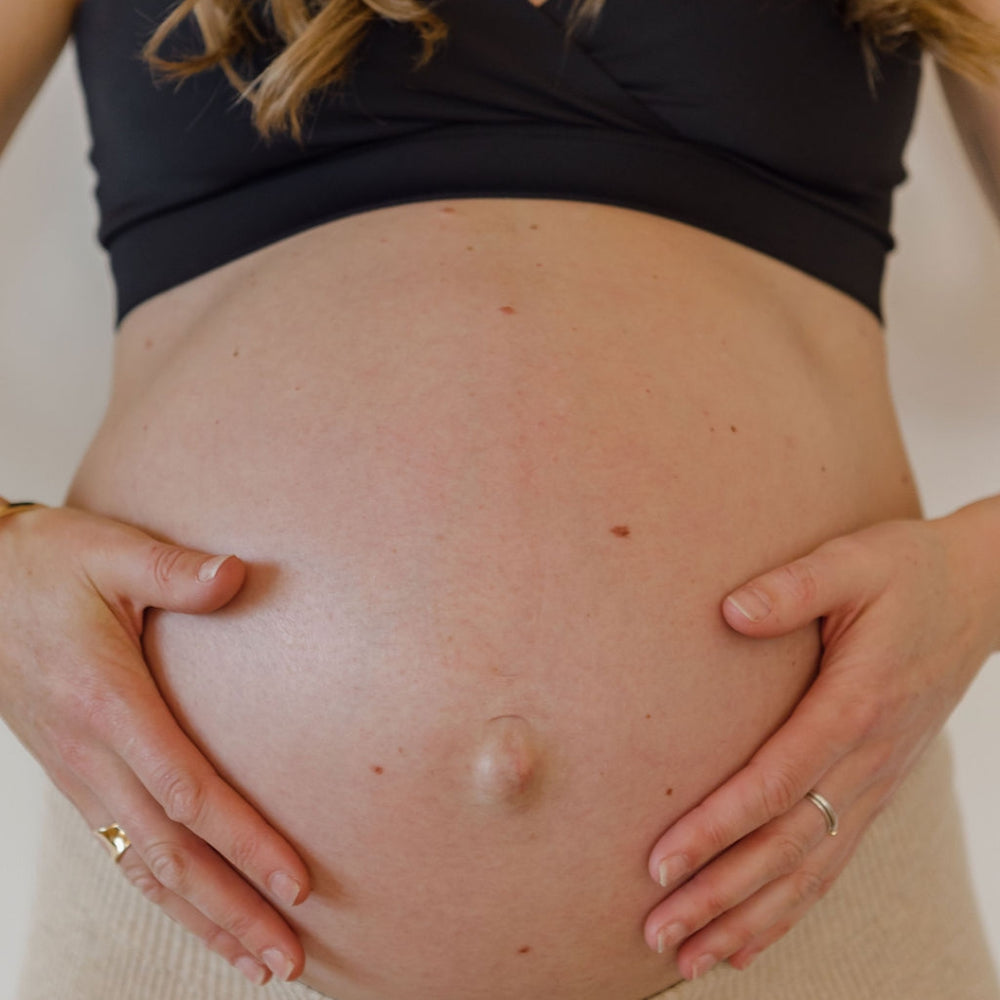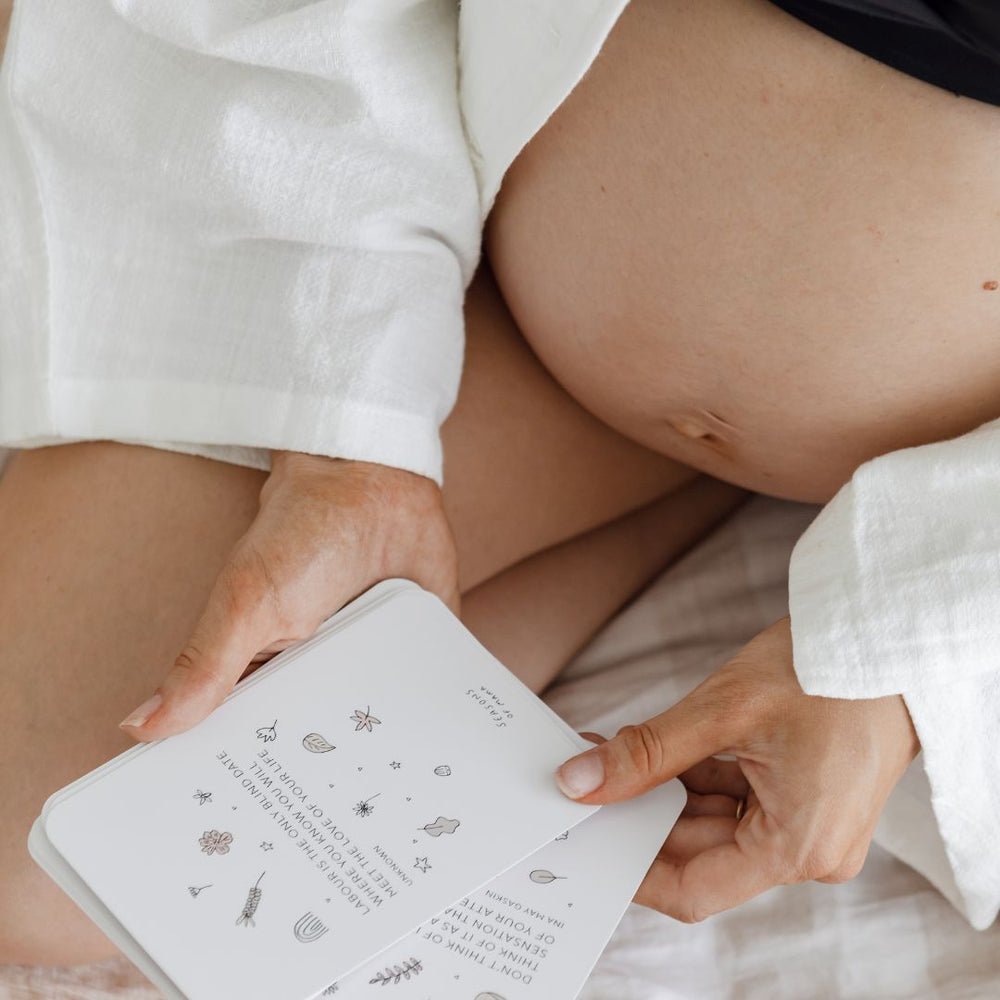Get ready mama, your body is about to do something amazing. And we’re not just talking about growing a tiny human for the past several months, but nurturing them now they’ve made their entry into the world.
Every mum’s baby feeding journey may look a little different, particularly if you choose to breastfeed or not, but one thing to remember while you’re taking care of your newborn is how to take care of yourself.
We chatted with expert Lactation Consultant (IBCLC) and midwife Kerrie Adams, to help give you a guide to the best boobie care after birth.
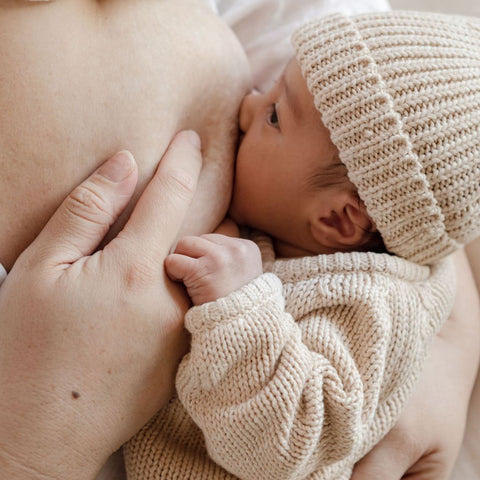
How do I take care of my breasts after giving birth?
Should you wear a bra after giving birth?
Wearing a bra after birth is completely dependent on your preference. But choosing the right nursing bra for postpartum comfort is just as important for the practicality of breastfeeding as it is for your own self-care.
“It used to be that a firm, supportive bra is better, but that advice has now changed,” says Kerrie.
“Allowing the breast to have as much free movement as possible is best practice so that there is no restriction with the milk coming in.”
Many new mums choose to wear a maternity bra, either for support or to sit breast pads in to avoid leaking while they adjust to their supply. But it’s also safe not to wear a bra at all. It’s all about what feels comfortable for you.
How often should you wash your breasts when breastfeeding?
You don’t need to wash your breasts more frequently than usual, so keeping them clean with warm water in your daily shower or bath will be fine. However, you should avoid using soaps on your breasts and nipples as it can cause your skin to dry out. You should also make sure to wash your hands before touching your breasts to help keep them clean and avoid any transfer of infection if you have a cracked nipple.

Breastfeeding after a caesarean
Postpartum care after having a c-section can sometimes look a bit different, however, most of your postpartum breast care will look the same. The one thing to look out for is a potential delay in breastfeeding, which can be more common with c-section births.
“It’s important to know how to hand express in case the baby doesn’t latch well in the beginning and is slow to feed,” says Kerrie.
“Breast stimulation is so important at birth, and beyond, for the longevity of breastfeeding and supply. If the baby can’t feed, then we must provide the stimulation ourselves.”
Gently massaging the breast to encourage your let-down reflex for hand expressing, or a manual or electric pump is one of the best ways to stimulate milk flow. Make sure you chat with your birth team or lactation consultant to get it right in those early days.
How do I stop my breasts from engorgement when not breastfeeding?
Breast engorgement is the swelling and hardening of the breast that occurs when you have too much milk. It can often be accompanied by pain, redness, and warmth in the affected breast.
If you choose not to breastfeed then you don’t need to worry about stimulating milk production after birth. However, this doesn’t necessarily mean that you’ll avoid engorgement altogether as your body adjusts its expectations of feeding.
If you do experience some post-birth engorgement in the early days, you can manage this with pain medication and breast cold packs.
However, if you have already started the process of breastfeeding and then choose to stop (for whatever reason), Kerrie advises a more planned approach.
“If we decide to stop established breastfeeding it’s a slightly more complex plan of decreasing feeds over time,” she says. “This deserves a more attentive approach with some professional guidance to avoid getting mastitis.”

Breast pain after pregnancy
How do you relieve breast engorgement?
Your body will produce milk on demand, meaning that the more you feed, the more you will produce to keep up with supply. So you’ll likely suffer from some discomfort in those early days as you and your new babe are figuring one another out. But don’t worry, says Kerrie, because this is usually a good sign that your milk is coming in properly.
“We don’t want to discourage the body from doing its natural thing,” Kerrie says.
“The most important thing is to keep your baby close, skin to skin, and feed them frequently and on-demand while the breasts settle down. Let them feed as long as they want to. If they sleep too long, wake them and feed them to help the engorgement.”
Engorgement will usually pass quickly, within a day or two, and while your breasts will feel full they should no longer feel painful. In the meantime, Kerrie advises taking anti-inflammatory pain medications (such as ibuprofen) or using homeopathy to soothe your breasts. Warm washers or breast inserts before feeding will help encourage flow to relieve pressure, while cool packs post-feeding can also soothe some pain (check out our favourite warm and cool breast care inserts from Mère and Bare Mum).
“Breast engorgement requires gentle and simple management,” Kerrie says. “Occasionally we can become engorged further down the track if we skip any feeding sessions. It’s important to get your baby to feed and help relieve your breast as soon as possible.”
Expressing, whether manual or by a pump, can also help relieve some pain after skipped feeds or when engorged. But make sure you’re not stimulating a larger milk supply, as you’ll worsen the situation in the long run by creating more milk than you need.

Does engorgement lead to mastitis?
If not appropriately treated, an oversupply of milk like engorgement can lead to ductal narrowing. This, in turn, could result in mastitis. However, if treated appropriately, most instances of engorgement are resolved with simple methods within a few days.
How to distinguish between mastitis and a clogged duct
Now known as ductal narrowing, a clogged or plugged duct is where inflammation causes your ducts to narrow and let less milk through. This can be caused by both oversupply (hyperlactation) as well as inadequate drainage and can progress to inflammatory mastitis if not treated appropriately.
“Mastitis is an infection in the breast that can occur from a plugged duct or when bacteria enters the breast, usually due to cracked or damaged nipples,” Kerrie explains.
“It’s usually accompanied by fever, chills, and flu-like symptoms. The breast can also be angry, red, and hot to touch.”
“By comparison, a clogged duct or ductal narrowing usually has no other symptoms except for a hard lump in the breast. It may cause some pain and discomfort, and can lead to mastitis, but is not that in the first instance.”
Wearing ill-fitting or tight bras, or restrictive clothing, can also restrict your milk flow and cause ductal narrowing. Kerrie says:
“It is important we allow the body free movement to prevent blockages in the ducts and allow the lymphatic system to be free-flowing, which also supports breastfeeding. The key to good drainage is a baby that latches well and feeds effectively.”
Ductal narrowing can be treated by anti-inflammatory measures, such as medications, cold compresses, or homeopathy. It’s also important to continue feeding (or expressing) as your baby’s suction can help stimulate milk flow through the narrowed ducts. Aggressive massage is not recommended as it can cause more inflammation and make the problem worse.

Preventing mastitis while breastfeeding
The best way to prevent a case of mastitis is to treat other breast problems before they can worsen.
However, if you do find that your breast pain is getting worse and you have common indicators such as fever, chills, or flu-like symptoms, it’s important to seek professional help and follow mastitis care guidelines as soon as possible.
The most up-to-date advice for treating mastitis as of 2023 is to:
- Feed on demand (it is safe to feed even with mastitis. Let the baby help you and keep draining the breast adequately).
- Rest (the most important thing alongside adequate drainage).
- Use ice to soothe and reduce inflammation.
- Use anti-inflammatory medications to soothe pain and reduce swelling.
- Use gentle, light massage (think about how your baby massages your breast while feeding). Anything too hard will worsen the problem.
- Take Sunflower Lecithin to help reduce the stickiness of your milk and reduce the rate of clogged ducts.
- Take a good breastfeeding-relevant probiotic, which has been proven to prevent and reduce the incidence of mastitis.
If the symptoms of mastitis are managed early and effectively, antibiotics are not always required. But if ductal narrowing or mastitis is recurring regularly, make sure you seek professional help from your GP or lactation consult to help resolve the issue for good.
Kerrie also advises the use of homeopathic remedies, which from her experience can do wonders in the prevention and treatment of mastitis.
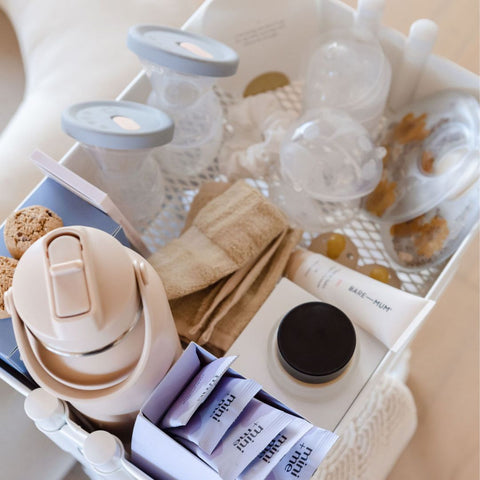
Nipple care for breastfeeding mums
How do I stop my nipples from hurting while breastfeeding?
While you may feel some discomfort in your nipples when first getting used to the sensation of breastfeeding, pain-free breastfeeding is all about the latch and positioning of your baby.
“If the latch and position are good, and the baby has optimal oral function, then your nipples should not ever crack or feel sore,” Kerrie says.
“Learning about good latch technique prior to your babe arriving statistically enhances your chances of breastfeeding success. Then having someone on hand with a depth of breastfeeding knowledge to check the latch technique with you will further enhance the journey to success.”
Of course, we know that things don’t always go to plan. So, if you do find that your nipples are aching or cracking, Kerrie recommends using a lanolin or natural oil-based balm that is breastfeeding-approved to soothe and promote healing.

What is the best way to prepare nipples for breastfeeding?
Unfortunately, there is no known way to prepare your nipples for breastfeeding before you start. Check-in with a specialised lactation consultant if you’re constantly experiencing nipple pain and want to get to the bottom of the issue.
Can I breastfeed my baby with cracked nipples?
While it may be uncomfortable, it is still safe to feed your baby with cracked or damaged nipples. Help promote healing with a breastfeeding-safe nipple balm (like these ones from Bare Mum or Mammae), or give yourself extra protection during the healing process by feeding with a nipple shield.
If breastfeeding is one of your mum-journey goals, make sure you chat with an expert lactation consultant to help you get the best breastfeeding support, or reach out to Kerrie Adams for one of her clinic appointments, home visits, or online consultations today.

